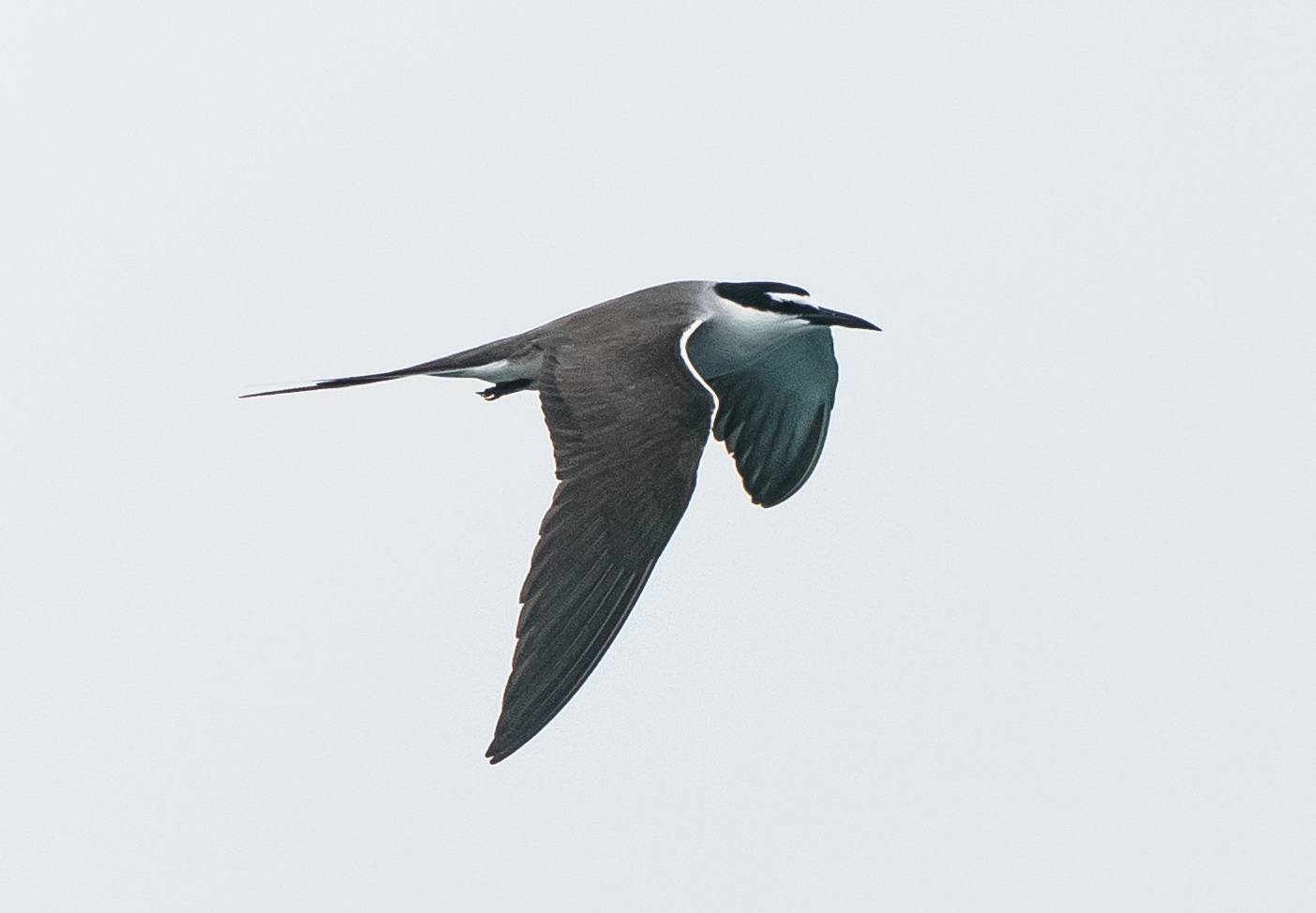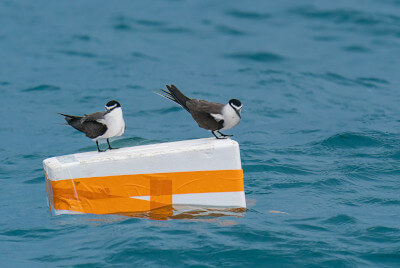
Bridled Tern ©Kenneth Lam
Common name: Bridled Tern
Scientific name: Onychoprion anaethetus
Local names: Бурокрылая крачка(Russian), 褐翅燕鸥 (Simplified Chinese), 褐翅燕鷗 (traditional Chinese), 에위니아제비갈매기 (Korean), マミジロアジサシ(Japanese), Dara laut kendal (Indonesian), Camar Batu (Malayu), Nhàn lưng nâu (Vietnamese), นกนางนวลแกลบคิ้วขาว(Thai)
Conservation status: IUCN - Least Concern
Bridled Tern is a widespread seabird found in warm oceans around the world. They are fairly common in the tropical seas. It is a strictly marine species but is often found in offshore waters instead of open oceans.
Identification
Identification:
 Adult Bridled Tern ©Kenneth Lam |
 Immature Bridled Tern ©Kenneth Lam |
- Size: 30–32 cm; wingspan 77–81 cm.
- Body: medium-sized, with long and narrow wings as well as long and deeply forked tail with white. Wings, back and tail brownish-grey color. Underwing and body white color. Head: black cap with white forehead and a white stripe above the eyes. White chin and beck
- Beak: black and as long as the head
- Legs and feet: blackish
- Juvenile: coloration is similar but duller than adults, but with some scaling and streaking to the upperparts
A similar species to Bridled Tern is Sooty tern as general plumage color of upper surface, but could be distinguished by its larger size (33 -36 cm; wingspan 82 -94 cm) and head pattern, which the latter has less of the white forehead and lack white stripe running above and extending after the eyes.
Distribution range
The breeding range is widespread, mainly in subtropical and tropical west Pacific, Atlantic, and Indian Oceans. In EAA Flyway, It breeds on the west coast of Thailand, east Gulf of Thailand, Malaysia, and south to Indonesia and Australia, towards the west to north of Philippines and islands off Southeast China. Its known northernmost breeding sites are Zhongjieshan Islands of Zhejiang, and Toku-no-jima of Kagoshima Prefecture, Japan.
Wintering range is understudied but basically in oceans of their breeding grounds. Birds breeding in China were found wintering at the Gulf of Thailand, Natuna Sea, Sulu Sea and Makassar Strait in Southeast Asia.
Habitat
-
Breeding habitat
Bridled Tern breeds on offshore rocky islands of limestone and volcanic stacks, vegetated coral cays and exposed reefs. Also found breeding on slopes of sandy dunes, under low vegetation and cliff-holes in some colonies.

Breeding habitat of Bridled Tern ©Kenneth Lam
-
Non-breeding habitat
Entirely aerial and marine during non-breeding season.

Bridled Tern at non-breeding period, resting on flotsam ©Kenneth Lam
Behavior
Bridled Terns showed an uncommon breeding pattern, in some populations, they has synchronous, subannual breeding cycles (breeding interval is less than one year) that coincide with molt. Some breeding pairs maintain with the same partners over successive seasons. Breeding space is highly dispersed and unevenly. Typically laying 1 egg per clutch. They are frequently found at mixed colonies with Black-naped Terns and Roseate Terns in South China and Southeast Asia waters.
Population estimate
Global estimated population: The global population is estimated to number c. 400,000-1,000,000 individuals. Its population in the EAAF is not yet estimated but it is one of the most common coastal breeding terns in tropical and sub-tropical Asia.
Main threats
- Human disturbance, e.g. recreational and tourism activities at breeding site trigger nest abandoned
- Egg collection and chicks harvest
Other threats:
- Pesticides and Other Contaminants/Toxics, e.g. oil spills risk
- Plastic pollution
- Exotic predators
Conservation Work
Hong Kong has started tracked study of breeding tern species. In 2017, the Agriculture, Fisheries and Conservation Department (AFCD), Hong Kong SAR Government attached color flags to 19 adult and juvenile Bridled Terns in August 2017. In 2018, Hong Kong Bird Watching Society (HKBWS, EAAFP Partner) started conservation research on breeding terns in Hong Kong waters, with support from the Japan Fund for Global Environment (JFGE). HKBWS deployed marking with rings and coloured flags on a total of 110 adult and juvenile Bridled Terns trapped during breeding season in 2019m including two individuals fitted with satellite-tracking transmitters. (Note: speciall permit issued by AFCD, HKSAR)
Tracking study of Bridled Tern ©HKBWS
Fun Fact
The specific name of Bridled Tern, anaethetus, is derived from a Greek root meaning senseless or stupid, a reference to its tameness and ease of capture by hungry sailors.
One Bridled Tern found injured (and later died) at Nago City, Okinawa, Japan on 13 October 2014 was found to be banded in Persian Gulf in Iran (as chick) on 28 July 2013. The bird travelled more than 7,450 km (linear distance) and was the first Iranian banded bird recovered in Japan (link).
References
IUCN Red List: https://www.iucnredlist.org/species/22694730/154676367
Birds of the World: https://birdsoftheworld.org/bow/species/briter1/cur/introduction
Projects on terns in Hong Kong:

